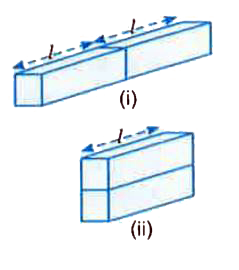Two identical slabs, of a given metal, are joined together, in two different ways, as shown in Fig.(i) and (ii). What is the ratio of the resistances of these two combinations ?

Let each slab has length l and cross-section area A. Then in combination (i), R1=ρ2lA and in combination (ii), R2=ρl2A
⇒R1R2=41 or R1=4R2
Topper's Solved these Questions
- CURRENT ELECTRICITY BOOK - U-LIKE SERIESCHAPTER - CURRENT ELECTRICITY EXERCISE - SHORT ANSWER QUESTIONS
42 Videos
- CURRENT ELECTRICITY BOOK - U-LIKE SERIESCHAPTER - CURRENT ELECTRICITY EXERCISE - LONG ANSWER QUESTIONS - I
47 Videos
- CURRENT ELECTRICITY BOOK - U-LIKE SERIESCHAPTER - CURRENT ELECTRICITY EXERCISE - ASSERTION-REASON TYPE QUESTIONS
5 Videos
- CBSE SAMPLE QUESTION PAPER 2019-20 (SOLVED)BOOK - U-LIKE SERIESCHAPTER - CBSE SAMPLE QUESTION PAPER 2019-20 (SOLVED)EXERCISE - SECTION D
6 Videos
- DUAL NATURE OF RADIATION AND MATTERBOOK - U-LIKE SERIESCHAPTER - DUAL NATURE OF RADIATION AND MATTEREXERCISE - SELF ASSESSMENT TEST SECTION-C (VERY SHORT ANSWER QUESTIONS)
3 Videos
Similar Questions
Two identical slabs of given metal are joined together in two different ways as shown in figure. What is the ratio of the resistance of these two combinations?

View SolutionTwo similar planoconvex lenses are combined together in three different ways as shown in the adjoining figure. The ratio of the focal lengths in three cases will be

View Solution
Knowledge Check
Two glucose molecules are joined together by
APeptide bondBGlycosidic bondCHydrogen bondD3',5'-phosphodiester bondTwo similar planoconvex lenses are combined together in three different ways as shown in the adjoining figure. The ratio of the focal lengths in three cases will be
 A2:2:1B1:1:1C1:2:2D2:1:1
A2:2:1B1:1:1C1:2:2D2:1:1If two resistors of 25Ω and 15Ω are joined together in series and then placed in parallel with a 40Ω resistor, the effective resistance of the combination is:
A0.1ΩB10ΩC20ΩD40Ω

Two rods having equal lengths and equal cross-sections but different specific resistances ρ1 and ρ2 are joined at one end as shown in the figure given above. What is the effective specific resistance of the combination ?
View SolutionTwo identical uniform rods of length l are joined to from L shaped frame, as shown is Fig. Locate the centre of mass of the frame.

View SolutionTwo cells of emfs E1 and E2 are connected together in two ways shown here. The 'balance points' in a given potentiometer experiment for these two combinations of cells are found to be at 351.0 cm and 70.2 cm respectively. Calculate the ratio of the emfs of the two cells.

View SolutionTwo cells of emfs E1 and E2 are connected together in two ways shown here. The 'balance points' in a given potentiometer experiment for these two combinations of cells are found to be at 351.0 cm and 70.2 cm respectively. Calculate the ratio of the emfs of the two cells.

View SolutionA wire that has resistance R is cut into two equal pieces. The two parts are joined in paralled. What is the resistance of the combination?
View Solution
